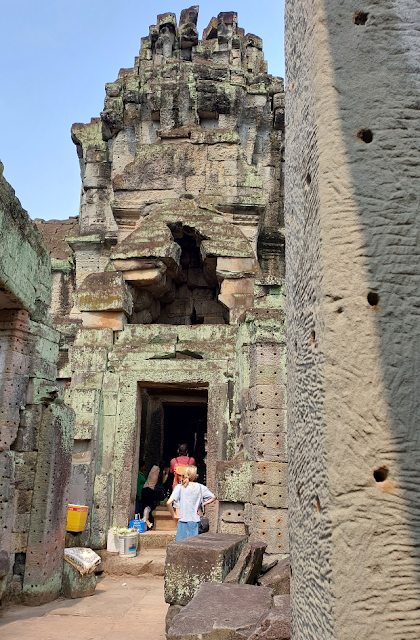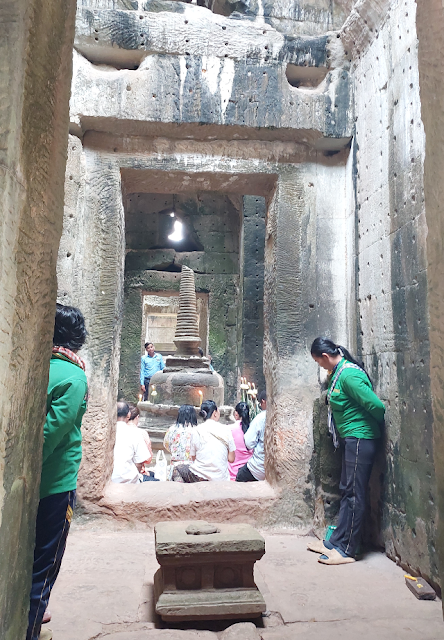This section of the temple is sanctum sanctorum and most sacred. It is surrounded by 1st enclosure which houses small temples.
The first enclosure or the inner enclosure, measuring 55 meters square, contains the central sanctuary and holds the highest sacred value within the temple. Positioned at the center and forming a cruciform layout, it offers views of gopuras in all four directions. This enclosure is divided into four sections, each filled with small shrines. Navigating the temple can be confusing, resembling a maze due to the
many turns and balancing required on the large stones. At times, I found
myself returning to the same spot.
Now, let's talk about navigating the temple. Brace yourself, as it can feel like a bit of a maze. With its twists and turns, finding your way around becomes quite an adventure. Balancing on the large stones adds an extra challenge, and you might even find yourself circling back to where you started. It's all part of the fun!
east entrance
entrance past Hall of Dancers
West of central sanctuary is a Shivlinga. It was probably moved from central sanctuary where the Lokeshwar image existed. The Sri Lankan style chedi was built and placed many years later. It must have been erected when Theravada Buddhism replaced Mahayana in Cambodia.
looks like the King himself
Mandapa of Preah Khan:
As you enter from the east, you'll encounter the Mandapa of Preah Khan, the main entrance to the central sanctuary. Although you can approach the sanctuary from any direction, the east-facing entrance is considered the most auspicious.
The central sanctuary has a shikhar or a tower or meru over the main stupa. The east side connects to Hall of Dancers. This enclosure is divided into four parts by a cruciform gallery.
A bell-shaped chedi has replaced original image of Lokeshwar which once stood here.
On observing closely, one sees holes all around the central sanctuary. The walls are said to have gilded bronze plates fixed all around.
16th century stupa
a prayer ceremony in progress
The stupa is still active. A prayer ceremony was taking place when we visited.
The central sanctuary is divided into four parts, and its beauty can be
appreciated from any entrance.
Shrines in enclosure 1:
The first enclosure is a cramped space
filled with 24 single shrines, some of which have been damaged over
time. The shrines' exteriors are adorned with decorative vines,
ascetics, and devtas. But some pediments are beautiful.
North-western courtyard:
In the northwestern courtyard, the temples are closely placed and
irregularly arranged, creating a challenging path between them. I hopped from one to another. The
shrines in this area feature sage figures in niches, with rich leaf
decorations on top. Short pillars with pegs are a distinctive feature
here.
Most of the time it was impossible to balance between the huge stones
The shrines have sage sitting cross legged in niches. Top of niches are richly decorated with leaves.
The temples in this courtyard are cramped. One special feature of this courtyard is the presence of short pillars with peg on top.
pillar with peg in courtyard
Was something kept on top of these pegs? Lotus petals can be seen on the pillar.
Apsara on a temple tile
pediment pieces on floor
hermits at the base of shrine
inside western temple
Shiva on pediment in one shrine
Shiva performing tandava
South-western courtyard:
The southwestern courtyard presents a more organized layout, added later
to the temple. It is squeezed tightly but offers a neat arrangement. It faces the southwest, symbolizing ancestor shrines.
very narrow passage between two small shrines, pillar with peg visible straight ahead
closely spaced shrines
pediment showing Lokeshwar
very well preserved pediment of Lokeshwar
upper part of pediment missing, lower part shows ancient elephant riding practice
lintel and side of a small shrine
Shrine of Queen Indradevi and Queen Jayarajadevi:
Before exiting, don't miss the small shrine near the eastern side, which
can be easily overlooked.
To
the north of the eastern central tower, on the north side before the
central shrine, this giant cottonwood tree has become integrated into the temple's wall.
Nearby,
there's a hidden shrine dedicated to Queen Indradevi.
Turning north side, ducking through a small "hole" is a small shrine of Queen Indradevi.
Queen Indradevi
Queen Indradevi was the sister of King's first wife, Jayarajadevi. She is said to be very smart and known for her wisdom. She was assigned as the head of a Buddhist temple. She taught woman-disciples and wrote the inscription known as the Phimeanakas Inscription which was found in the Phimeanakas temple. The inscription written in Sanskrit gives information about the King and the role of the two Queens in spreading Buddhism.
On the right side, crane your neck to see almost hidden image of Queen Jayarajadevi. King Jayavarman VII, first married Jayarajadevi before he became the king. After her demise, he married her sister, Indradevi.
A relief with Buddha figures on the north wall has suffered
damage from water seepage. It was impossible getting a clear picture.
Dwarpala before exiting:
Just before entering the second enclosure, you'll encounter two
beautiful Dwarpala images on either side. The lighting conditions may
make it difficult to capture both together.
After exploring Prasat Preah Khan, most visitors exit through the east
entrance. However, I recommend taking the opportunity to visit the
nearby Neak Poan temple, a short six-minute journey from here.






























































